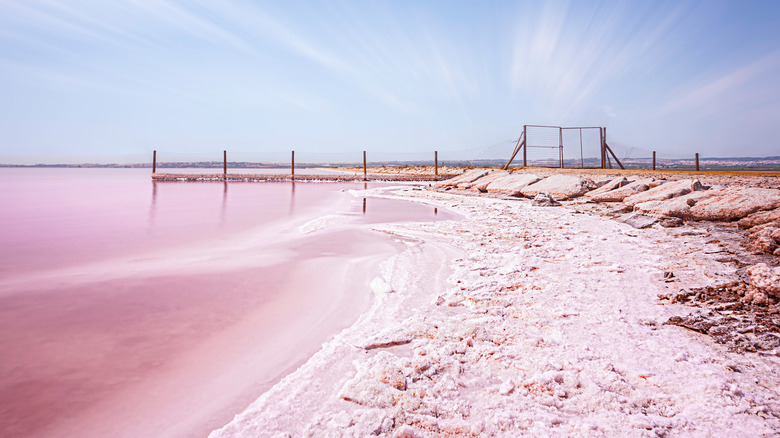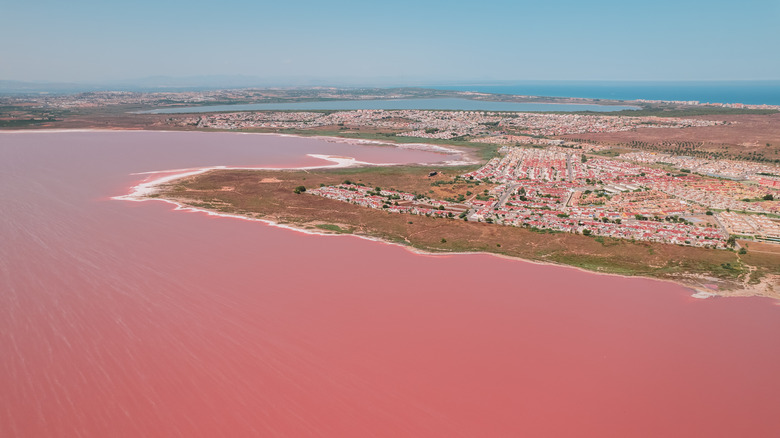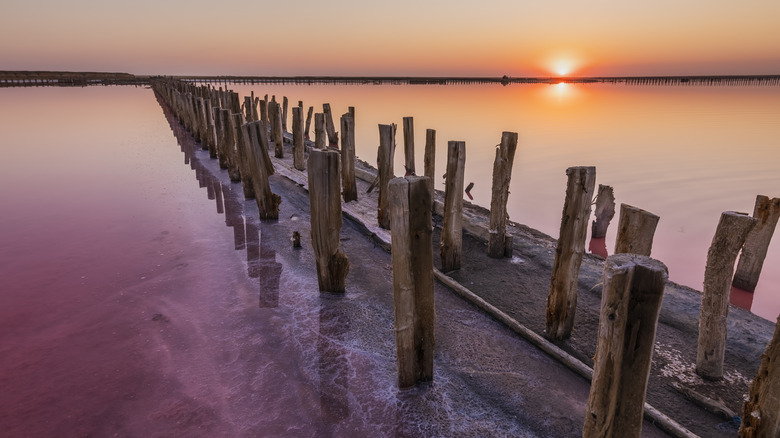This One-Of-A-Kind Bubblegum Pink Lake Is A Must-Visit On A Trip To Spain
Paella, tapas, late-night merriment, and afternoon siestas make Spain a unique place to visit. Your vacation there might even be affected by Spain's siesta culture. Their days are typically long and their restaurants are known to close well after midnight. There is a sense of warmth and richness in the air attributed to many things, including Flamenco music and dance, plenty of sunshine, bullfights, and gorgeous beaches.
Something else stands out if you find yourself in the resort town of Torrevieja on the Costa Blanca during a visit to this must-see European country. An aerial view of Torrevieja shows you a bubblegum pink lake just outside of the city. The lake is rose-hued, and it's that way for a reason. In English, you might hear it be called the Pink Lake in Torrevieja, but its Spanish name is Laguna Salada de Torrevieja.
While the color might look unnatural at first, what's going inside the lake is actually a natural phenomenon. The hue is attributed to a certain kind of bacteria and algae that live inside it — halobacterium (salt bacterium) and Dunaliella salina. Turns out, both of these species thrive in particularly saline water and they are pink in color. Laguna Salada de Torrevieja has high concentrations of salt in it, so much so that you'll find large salt crystals in the lake. More on the salty lake and how it came to be below.
How exactly is the salty lake in Torrevieja pink?
Dunaliella salina algae contain a very high concentration of a carotenoid pigment called beta-carotene (the same thing that gives certain fruits and vegetables their particular hue). Halobacterium have a pigmented protein called bacteriorhodopsin, which they use to absorb energy from the sun. Both of these factors lend themselves to make the Torrevieja lake pink.
These bacteria and algae aren't the only creatures that call the lake home, however. There's also saltwater brine shrimp (Artemia salina Crustaceans). They are pink because they feed on the rosy-hued microorganisms and algae. What's more, the lake is visited by thousands of flamingos during breeding season, who feed on this shrimp and end up sporting pink-tinted feathers. Talk about fascinating things that happen because of food chains.
The salinity of the lake itself has somewhat of an interesting history. Torrevieja has relied on its salt lakes (another blueish green one sits close to the town) for centuries. There is even some talk of how the lakes have healing properties because of their high concentration of salt. The mud there is also thought to be "healing." Travelers to the lake say it resembles a pink spa, with people applying mud on their skin and exfoliating with salt crystals.
How to get to Spain's pink lake (and things to consider)
Laguna Salada de Torrevieja is about a 4-hour, 25-minute drive from Spain's capital, Madrid. However, if you're holidaying in the town of Torrevieja, which is about 40 minutes south of Alicante airport, you can bike to the lake in about 20 minutes. You can get there by car, bus, or by using Blablacar, a rideshare app that's popular in Spain. There are excursions you can book from Alicante as well, which include a tour to the rosy waters. These might cost you around $75. If it's your first time in Spain, it helps to learn some Spanish phrases. Navigating becomes easier that way.
Once you get to the lake, you may notice that the water looks murky. There might also be an unpleasant smell. This could be related to the bacteria, shrimp, and algae. Tripadvisor reviews noted quite a bit of garbage strewn about as well. That being said, the lake is truly a marvel to feast your eyes on. From afar, you might not be able to see its vibrant hue, so make sure to get up close. Sunny and windless days help bring out the color too.
As tempting as the bubblegum hue might be, you are not allowed to swim in the lake. You'll see signs to that effect in the area. Not only will you disrupt the lake's fragile ecosystem, but you could end up contaminating the salt that supports the town's salt industry. There is even a hefty fine of 6,000 euros if you're caught breaking the rule.


